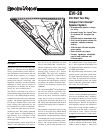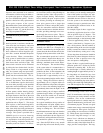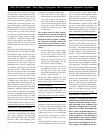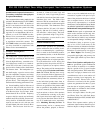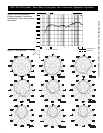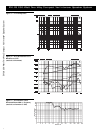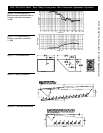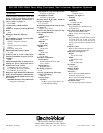
EVI-28 250-Watt Two-Way Compact Vari Intense
®
Speaker System
EVI-28 250-Watt Two-Way Compact Vari Intense
®
Speaker System
3
term average level stresses the speaker
thermally (heat). The instantaneous peaks
test mechanical reliability (cone and dia-
phragm excursion). The sine-wave test sig-
nals sometimes used have a much less de-
manding peak value relative to their aver-
age level, providing a much higher power
handling specification than is appropriate
for real-world use. In actual use, long-term
average levels exist from several seconds
on up, but we apply the long-term average
for eight hours, adding another measure
of reliability. Additional extremely high-
stress tests developed in-house push com-
ponents to the limits to ensure long-term
reliability under the most extreme cases of
abuse.
Specifically, the EVI-28 is designed to with-
stand the power test described in ANSI/
EIA RS-426-A 1980. The EIA test spec-
trum is applied for eight hours. To obtain
the spectrum, the output of a white-noise
generator (white noise is a particular type
of random noise with equal energy per
bandwidth in Hz) is fed to a shaping filter
with 6-dB-per-octave slopes below 40 Hz
and above 318 Hz. When measured with
the usual constant-percentage bandwidth
analyzer (one-third-octave), this shaping
filter produces a spectrum whose 3-dB-
down points are at 100 Hz and 1,200 Hz with
a 3-dB-per-octave slope above 1,200 Hz.
This shaped signal is sent to the power am-
plifier with the continuous power set at
250 watts into the 6.9-ohm EIA equivalent
impedance. Amplifier clipping sets instan-
taneous peaks at 6 dB above the continu-
ous power, or 1000 watts peak. The EVI-28
has been thoroughly tested at an AES
equivalent power level of 350 watts con-
tinuous for 2 hours with 1,400 watt peaks.
This procedure provides a rigorous test of
both thermal and mechanical failure modes.
Amplifier Power Recommendations
As noted in the Power-Handling Capacity
section above, the EVI-28 has a random-
noise power capacity of 250-watts long
term (1000-watts peak) per ANSI/EIA
RS-426-A 1980. The following guide-
lines will help relate this number to an ap-
propriate power amplifier output rating.
1. To use the EVI-28 to full capacity,
skilled experts in sound-system instal-
lation and operation will obtain the
best results if the power amplifier is
2.0 to 4.0 times the long-term average
noise power rating of the speaker
system. For the EVI-28, this is 500
to 1000 watts.
The caution cannot be made strongly
enough, however, that this arrangement
is only for experts or for those who can
discipline themselves against “pushing”
the system for ever-higher sound levels
and who can avoid “accidents” such as
catastrophic feedback or dropped micro-
phones.
2. A more conservative, “normal” ampli-
fier size, which will produce audible
results nearly equal to those of the
“expert” recommendation, is 1.0 to 1.4
times the long-term average noise
power rating of the speaker. For the
EVI-28, this is 250 to 350 watts.
3. To be very conservative, one can use
an amplifier rated at 0.5 to 0.7 times
the long-term average noise power
rating of the loudspeaker. For the EVI-
28, this is 125 to 175 watts.
Request P.A. Bible Addition No. Two
(“Power Handling Capacity”) for more
background on these recommendations.
EVI-28 Connections
Electrical connections to the system are
made by large screw terminals able to ac-
cept up to 10-gauge wire, mounted to an
input panel on the back of the enclosure.
Speaker Protection
The EVI-28 like all other vented systems
experiences rapidly increasing cone excur-
sion below the box tuning frequency, while
the acoustic output decreases rapidly. To
ensure a long woofer life even when used
at high power levels, it is recommended
that some form of electronics be used to
control unnecessary woofer cone excur-
sion.
Graphic equalizers and active crossovers
are two methods that can be used to pre-
vent low-frequency signal below band-
pass from going to the loudspeaker. When
using and active crossover, a high-pass
filter with a cut-off frequency of 35- to 50-Hz
will provide the necessary protection. The
filter should have a slope of at least 12 dB
per octave. Such subpass band filters are
found in many crossovers and equalizers
manufactured by Electro-Voice, as well as
other commercially available equipment.
Enclosure Construction and Refinishing
The enclosure is constructed from high-
grade void-free 12-mm (0.5-inch) 9-ply and
18-mm (0.71-inch) thick 13-ply birch ply-
wood and lined with sound-absorbent cot-
ton batting. This high-strength enclosure
is coated with an attractive textured black
or white finish for a truly professional ap-
pearance. Systems with unfinished enclo-
sures suitable for staining come with a black
grille and may be ordered for a small addi-
tional charge. The included 3/8-16 hang-
ing points ensure easy installation in nearly
every application. The grille is constructed
from a sturdy 16-gauge medium-gloss black
or white powder-coated steel and may be
painted or covered with cloth to match the
enclosure. If the grille is painted, the acous-
tic foam insert should be removed during
painting and reattached with a contact or
spray adhesive on the grille, such as 3M
Super 77. Take extreme care to replace the
foam insert in its original position and pre-
vent paint or adhesive from covering the
foam, as it will obstruct the pores and de-
grade the performance of the system.
Suspending EVI-28 Enclosures
WARNING: Suspending any object is po-
tentially dangerous and should only be at-
tempted by individuals who have a thor-
ough knowledge of the techniques and
regulations of rigging objects overhead.
Electro-Voice strongly recommends that
the EVI-28 be suspended taking into ac-
count all current national, federal, state
and local regulations. It is the installer’s
responsibility to ensure that the speaker
system has been safely installed in accor-
dance with all such regulations. Electro-
Voice strongly recommends that all sus-



